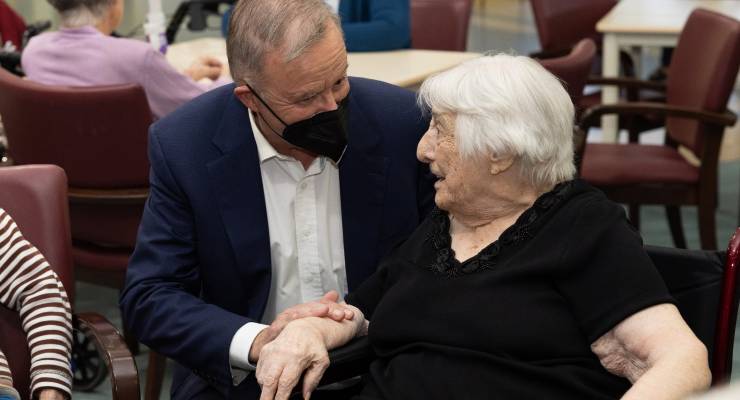
Alert! Alert all the care feminists out there (and I dearly hope we are growing in number). You may have missed a very important announcement this week.
But first, for the uninitiated, here’s what I mean when I talk about “care feminism”.
In my book Leaning Out, I devoted a whole chapter to the shift from career feminism to care feminism. I argued that we were emerging from a decade dominated by “empowerment” feminism that focused on what individual women should do to overcome decades of inequality in the workplace. Fixing systems and tackling structural inequality? No thank you. Power posing and endless “confidence industrial complex” workshops aimed at fixing women? Yes please.
This dominant strain of feminism had delivered little, I argued, and it was time to chart a new course. In fact, Australia had slid significantly down the World Economic Forum’s gender equality rankings while career feminism reigned supreme. In 2013, the high-water mark of career feminism that saw the publication of Sheryl Sandberg’s Lean In, Australia ranked 24th. By 2021, it came 50th.
In career feminism’s place, I hoped we would move towards a much needed “care feminism”. This feminism grappled with the critical role care and “care infrastructure” played in our economy that makes it possible for women to do paid work — the same women who have traditionally been expected to do that care work for free.
Consider this: the monetary value of unpaid care work in Australia has been estimated to be $650.1 billion, equivalent to 50.6% of GDP. This makes it Australia’s largest industry, larger than any in the formal economy. That’s equivalent to the value of three mining industries.
What’s more, women’s paid work in female-dominated caring professions is scandalously undervalued. As a society we simply don’t value the paid caring work women do precisely because women do it. It’s something that we expect them to do for free or little pay “out of love”. The Diversity Council of Australia has found that this “undervaluing of women’s work” is one of the most significant drivers of the gender pay gap, accounting for nearly one-fifth of it.
Finally, the pandemic and demographic shifts have forced a reckoning on the “undervaluing of women’s work”, with many women in traditionally undervalued caring professions suddenly deemed “essential workers”.
“Show us the money” was a common retort to the pandemic era “claps for carers”.
This has all played out against a backdrop of the growing need for care workers that has resulted in paid care work forming a bigger part of the formal economy. Care jobs are now the “jobs of the future”.
This all brings me to the Albanese government’s announcement at the weekend. It launched a draft national strategy for the care and support economy alongside a high-level taskforce drawn from across the government that by June 30 will deliver a “strategy that sets a shared vision for the care and support economy in Australia”.
I am of two minds about these. On one hand, the fact that the strategy was launched by Albanese himself, who wrote a comment piece in which he encouraged Australians to have a say, is not insignificant. The prime minister leading a national conversation on these issues invites the public to go on this journey towards “care feminism”. And I do not wish to underestimate the need to coordinate reform on this issue across government — or what a massive task that is. For the avoidance of doubt: respect.
But I also fear they are a bit of a stopgap. The pandemic has opened our eyes to the value of care work and hastened that transition to “care feminism”. We know what needs to be done, but it won’t be cheap. Basically, we need to pay care workers more to avoid critical staff shortages in aged care, early years education and care, and disability support services. Government, as the primary funder of most care services, will have to foot the bill. Therein lies the rub.
The Albanese government has committed to a 15% pay rise for aged care workers after a 2022 Fair Work Commission case found their work was undervalued. But it had to be dragged (slightly) kicking and screaming. It wanted to phase in the pay rise (probably to soften the blow on a budget already under significant stress) but the Fair Work Commission said not so fast. So the $11.3 billion cost was factored into the 2023 budget.
Early years educators were not so lucky. The government declined to cede to union demands for a 25 % pay rise, ignoring warnings that the sector — already in crisis — would lose yet more workers to better paid aged care jobs. The need for immediate action was backed by the government’s women’s economic equality taskforce, which — ahead of the budget — wrote a letter calling for an interim pay rise for all early childhood educators in recognition of the historical undervaluation of their work and the urgent need to retain and attract workers.
What happens when the promised increased subsidies for childcare, which come into force in July, only increase demand for services (without the necessary staff to meet that demand) is anyone’s guess.
This is arguably something the government should have addressed in the budget while also committing to a taskforce and strategy to take a longer-term view.
So are we all “care feminists” now? Yes, I say. That we are talking about these issues, and that this long overdue conversation is being led by the prime minister, is huge. But the government’s application of “care feminist” principles is not yet entirely consistent.
Recently, Ai-jen Poo, president and co-founder of the National Domestic Workers Alliance in the US and executive director of Caring Across Generations (as well as the individual who is at the very vanguard of modern day “care feminism”) was asked: “What keeps you up at night?”
“I know too much about what is involved in actually making transformative change happen, and the level of transformation that is needed in our economic system and our care,” she said.
“I worry that by the time we are ready to embrace a major investment in the care infrastructure, and the political stars have aligned, the policy stars have aligned, and the cultural and narrative stars have aligned, that we will have created so much human suffering unnecessarily.”
I hear you, Ai-jen.








Australia is one of the richest countries in the world. There is plenty of money, it just needs to be distributed differently.
To paraphrase William Gibson “the wealth is already here, it’s just unevenly distributed.”
Intentionally, not a bug but a design feature.
No argument with most of this piece, but I wish Australian commentators would give pioneering NZ feminist economist Marilyn Waring due credit for saying a lot of this first- in 1988! https://www.marilynwaring.com/publications/if-women-counted.asp#:~:text=This%20is%20a%20revolutionary%20and,from%20value%20in%20economic%20theory.
Doesn’t care feminism also advocate support for people who want to engage in unpaid care work, who want to care for their own children? Ziwica places a whole lot of emphasis on the paid care infrastructure and seems to forget about infrastructure that actually supports unpaid work. Are you really a ‘care feminist’ if you really only want to support women in their paid work contribution? Or a career feminist who cares about the working conditions of people who are engaged in paid care work.